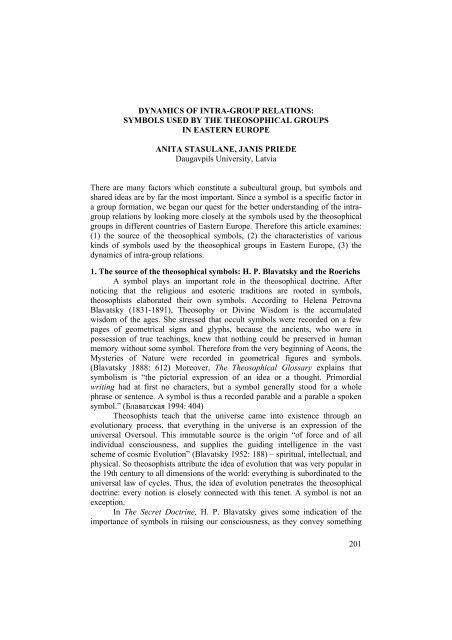culture, subculture and counterculture - Facultatea de Litere
culture, subculture and counterculture - Facultatea de Litere
culture, subculture and counterculture - Facultatea de Litere
You also want an ePaper? Increase the reach of your titles
YUMPU automatically turns print PDFs into web optimized ePapers that Google loves.
DYNAMICS OF INTRA-GROUP RELATIONS:<br />
SYMBOLS USED BY THE THEOSOPHICAL GROUPS<br />
IN EASTERN EUROPE<br />
ANITA STASULANE, JANIS PRIEDE<br />
Daugavpils University, Latvia<br />
There are many factors which constitute a subcultural group, but symbols <strong>and</strong><br />
shared i<strong>de</strong>as are by far the most important. Since a symbol is a specific factor in<br />
a group formation, we began our quest for the better un<strong>de</strong>rst<strong>and</strong>ing of the intragroup<br />
relations by looking more closely at the symbols used by the theosophical<br />
groups in different countries of Eastern Europe. Therefore this article examines:<br />
(1) the source of the theosophical symbols, (2) the characteristics of various<br />
kinds of symbols used by the theosophical groups in Eastern Europe, (3) the<br />
dynamics of intra-group relations.<br />
1. The source of the theosophical symbols: H. P. Blavatsky <strong>and</strong> the Roerichs<br />
A symbol plays an important role in the theosophical doctrine. After<br />
noticing that the religious <strong>and</strong> esoteric traditions are rooted in symbols,<br />
theosophists elaborated their own symbols. According to Helena Petrovna<br />
Blavatsky (1831-1891), Theosophy or Divine Wisdom is the accumulated<br />
wisdom of the ages. She stressed that occult symbols were recor<strong>de</strong>d on a few<br />
pages of geometrical signs <strong>and</strong> glyphs, because the ancients, who were in<br />
possession of true teachings, knew that nothing could be preserved in human<br />
memory without some symbol. Therefore from the very beginning of Aeons, the<br />
Mysteries of Nature were recor<strong>de</strong>d in geometrical figures <strong>and</strong> symbols.<br />
(Blavatsky 1888: 612) Moreover, The Theosophical Glossary explains that<br />
symbolism is “the pictorial expression of an i<strong>de</strong>a or a thought. Primordial<br />
writing had at first no characters, but a symbol generally stood for a whole<br />
phrase or sentence. A symbol is thus a recor<strong>de</strong>d parable <strong>and</strong> a parable a spoken<br />
symbol.” (Блаватская 1994: 404)<br />
Theosophists teach that the universe came into existence through an<br />
evolutionary process, that everything in the universe is an expression of the<br />
universal Oversoul. This immutable source is the origin “of force <strong>and</strong> of all<br />
individual consciousness, <strong>and</strong> supplies the guiding intelligence in the vast<br />
scheme of cosmic Evolution” (Blavatsky 1952: 188) – spiritual, intellectual, <strong>and</strong><br />
physical. So theosophists attribute the i<strong>de</strong>a of evolution that was very popular in<br />
the 19th century to all dimensions of the world: everything is subordinated to the<br />
universal law of cycles. Thus, the i<strong>de</strong>a of evolution penetrates the theosophical<br />
doctrine: every notion is closely connected with this tenet. A symbol is not an<br />
exception.<br />
In The Secret Doctrine, H. P. Blavatsky gives some indication of the<br />
importance of symbols in raising our consciousness, as they convey something<br />
201












